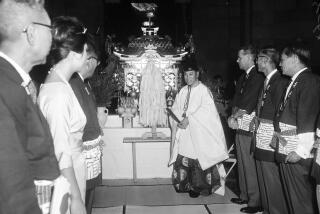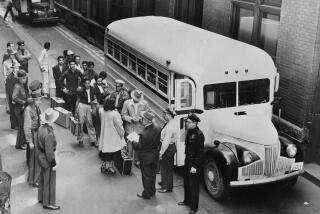California has a racist past. But removing monuments sparks debate about how to reflect an ugly history

- Share via
Every November for years, a yellow blindfold had been placed over the eyes of the bronze Prospector Pete statue that sits prominently on the Cal State Long Beach campus — an act designed to make clear that the school was not blind to the brutality inflicted on thousands of indigenous Americans during the California gold rush.
This year, however, top administrators announced that they planned to retire the mascot and move the statue to a less prominent place on campus, a soon-to-be-built alumni center.
For the record:
12:05 p.m. Oct. 8, 2018An earlier version of this article referred to Christopher Columbus as a Spanish explorer. He was Italian.
Amid a sweeping reappraisal of California’s history has come the growing acknowledgment that racism is at the heart of the state’s founding: White settlers flooded the region in the mid-1800s looking for riches, and native Californians — along with Asian and Mexican laborers — became the victims of discrimination and violence that presaged how minority groups would be treated for decades to come.
“We’re connected to the past whether we like it or not, and that strand is really fragile and fascinating,” said USC history professor William Deverell, who is wary of the idea that commemorative statues should be hidden away. California’s past, he said, should be discussed, “scrutinized and put on the scales of justice.”
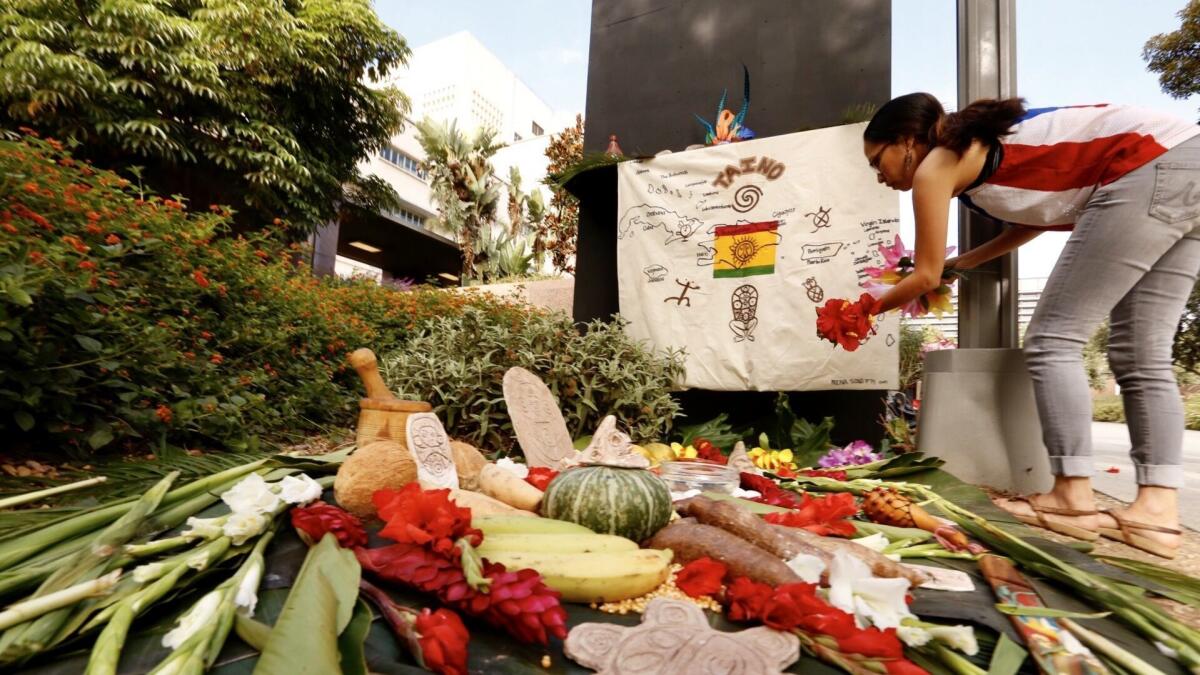
At Grand Park in downtown Los Angeles on Monday, a statue of Christopher Columbus was hidden beneath a black box as the city celebrated its inaugural Indigenous Peoples Day.
The City Council in 2017 voted to rebrand the Columbus Day holiday, which marks the arrival of the Italian explorer in the Americas. Lawmakers sided with activists who view Columbus as a symbol of genocide for Native Americans.
Among the few hundred people gathered in Grand Park was Soraya Medina, whose ancestors were part of an indigenous Caribbean tribe. Standing by the covered Columbus statue, she called it a shameful reminder of the European push into the Americas.
“The statue is a monument to genocide,” Medina said.
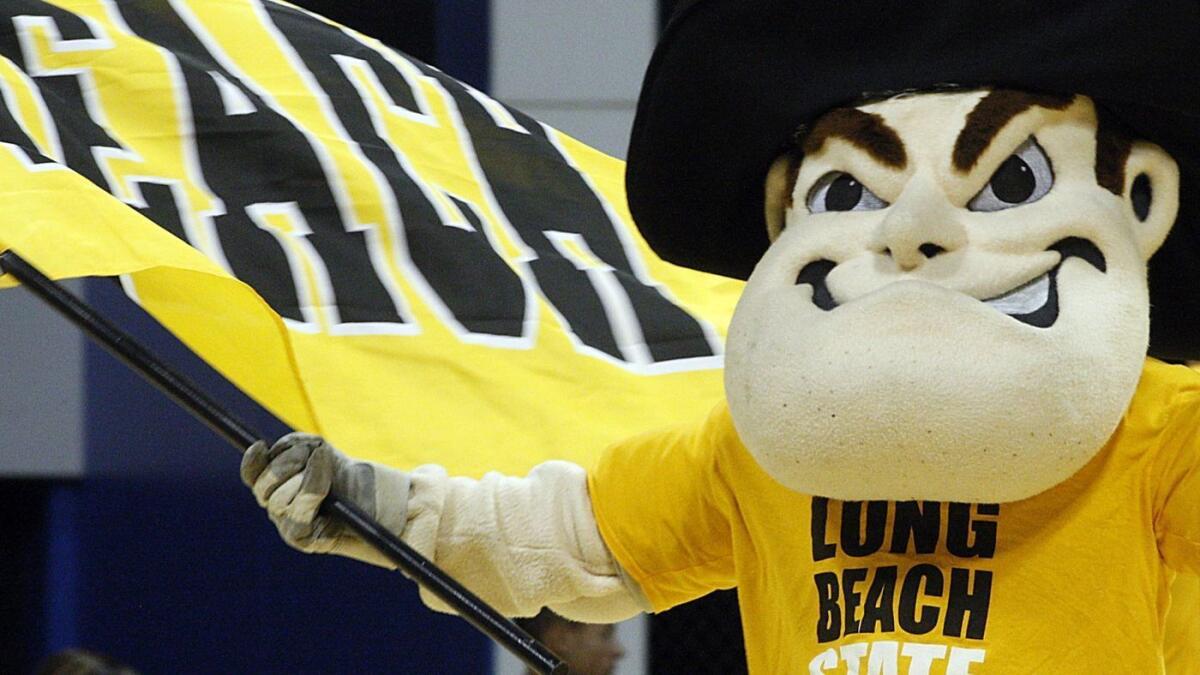
Other cities and institutions have taken action to try to deal with California’s ugly past.
Berkeley too celebrates the second Monday in October as Indigenous Peoples Day.
And the San Francisco Board of Appeals recently decided to remove the longstanding “Early Days” statue outside City Hall. Erected in 1894, the work depicts a Native American lying at the feet of a missionary as a vaquero stands nearby in triumph. Although the statue represents a common view of the time period, many say it is no longer appropriate to enshrine the monument as an accurate portrayal of history.
Stanford University last month decided to rename three campus references to Father Junipero Serra, who founded the California mission system in the 1700s and whose legacy came under fire for the missions’ treatment of Native Americans.
The 1849 gold rush marked the birth of modern California, and that’s how “the 49ers” became Cal State Long Beach’s symbol when the university opened a century later.
“As an institution dedicated to inclusivity, it is really important to us to have a mascot that empowers students,” said Leen Almahdi, a junior at Cal State Long Beach. “Prospectors had a direct link to the murder of indigenous people. It’s important for us to recognize this reality can make some communities uncomfortable.”
We’re connected to the past ... and that strand is really fragile and fascinating. It should be scrutinized and put on the scales of justice.
— William Deverell, USC professor of history
Activists have cheered the removal of symbols they consider offensive. But the actions also have sparked debate about where to draw the line, and the difference between understanding the past and celebrating it.
After Stanford decided to remove Serra’s name from its campus buildings, some questioned when the university would address its own namesake, Leland Stanford. The railroad baron and former California governor used Chinese labor to help build the transcontinental railroad but spouted virulently anti-Asian rhetoric and other racist views. Stanford infamously said of Asian populations in 1862 that the “presence of numbers among us of a degraded and distinct people must exercise a deleterious influence upon the superior race.”
California history is filled with actions that were accepted at the time but in retrospect have been met with shame and regret.
In 1909, for example, the state passed a law authorizing the sterilization of anyone committed to a state institution. The program, which took away the reproductive abilities of about 20,000 people, disproportionately targeted Mexican immigrants. Supporters believed that people they deemed genetically “unfit” shouldn’t be allowed to reproduce, according to historians.
The law remained on the books until 1979.
During World War II, the internment of thousands of Japanese Americans in isolated camps was praised by then-California Atty. Gen. Earl Warren, who went on to become chief justice of the U.S. Supreme Court. Despite his work expanding civil liberties while on the bench — most famously the 1954 Brown vs. Board of Education case that found racial segregation in public schools unconstitutional — internment remained a blemish on his record.
The ugliness of some of the state’s past can be difficult to wash away, especially for groups that were caught in the middle of oppressive situations.
“The past has not been buried,” Deverell said. “I have a professional obligation to say the past is standing right at our shoulder. It still exerts all this power.”
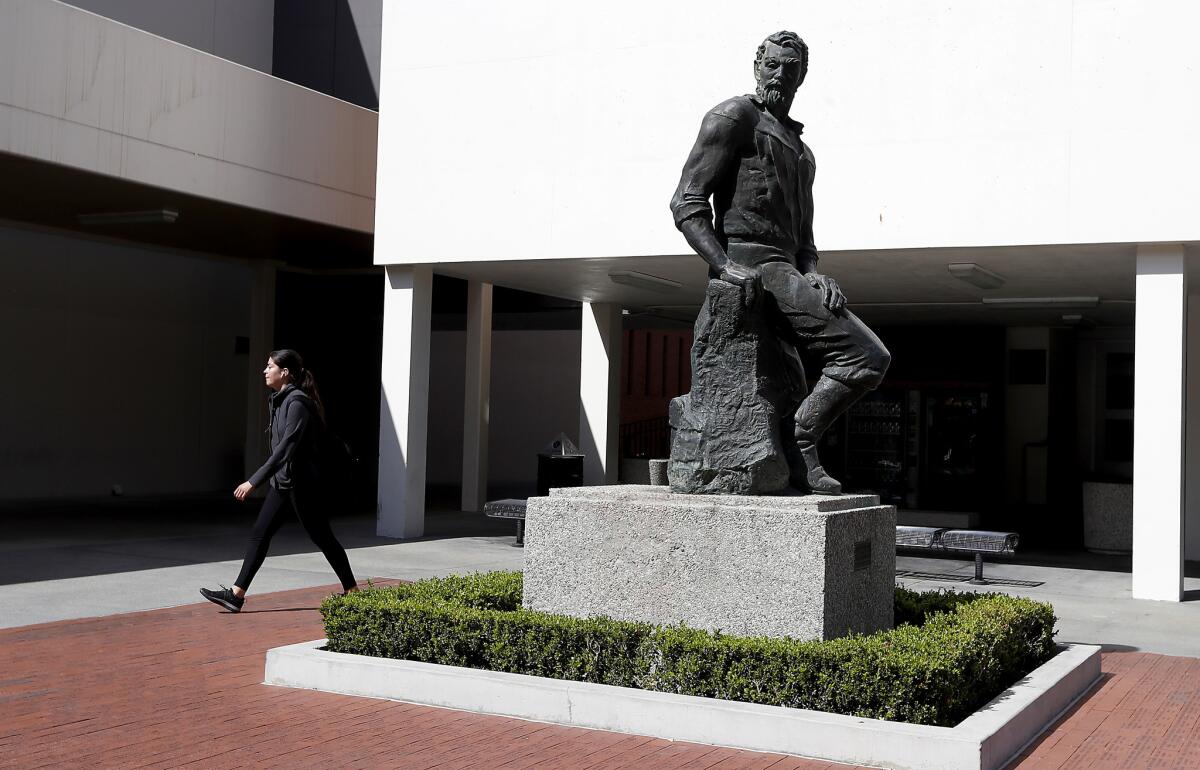
It’s a conflict that’s playing out across the United States, as dozens of monuments that activists say promote a time when the oppression of women and minorities was rampant are removed from public spaces. Leaders and historians are left to ponder how the past should be preserved without adding fuel to hate groups that sometimes use the symbols as a source of power.
“We’re at a moment when a lot of people feel particularly under threat, given the political climate,” said Michelle Brock, associate professor of history at Washington and Lee University in Virginia, adding that institutions and municipalities run the risk of alienating people by retaining offensive depictions of the past in the name of history.
“No one ever learns history from a statue that is set up to memorialize something,” she said. “It’s about projecting visions of the present and future, and often that’s whitewashed or inaccurate. Preserving history is a fundamentally different thing.”
The Prospector Pete statue, formally named “The Forty-Niner Man,” was unveiled at Cal State Long Beach in 1967. It evolved from founding President Pete Peterson’s reference to having “struck the gold of education” by establishing the college in 1949.
Garland Holt was on the student senate when the idea for a statue came up for approval. He said the intent was to honor the students at Cal State Long Beach at the time, many of whom were first-generation college attendees and pioneers in their own right.
Holt said he’s fine with retiring the mascot, but hiding the statue in a space dedicated to alumni is a mistake and insulting to former students. The campus, Holt said, “is a place where students who often could not gain the gold of an education can better themselves and help the world. That is what the prospector means to us.”
Times staff writer Alejandra Reyes-Velarde contributed to this report.
Twitter: @Hannahnfry
UPDATES:
3:25 p.m: This article was updated with details from Grand Park.
10:30 a.m.: This article was updated with information about a statue of Christopher Columbus in downtown Los Angeles.
8:25 a.m.: This article was updated with more details about California’s history.
This article was originally published at 7:15 a.m.
More to Read
Sign up for Essential California
The most important California stories and recommendations in your inbox every morning.
You may occasionally receive promotional content from the Los Angeles Times.

